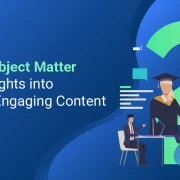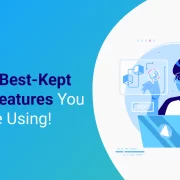
Six Practical Tips for Crafting Captivating Alt Text Across Content Types
Summary
This article highlights the importance of alt text and how it can improve accessibility and user experience.
In the interconnected network of the web, images are the threads that tie content together, drawing attention and enhancing narratives. But these visuals can remain opaque for those who depend on assistive technologies like screen readers. That’s where alt text steps in, acting as the bridge between the visuals and understanding.
Globally, 2.2 billion people have vision impairment, of which 1 billion are uncorrected. These figures paint a clear picture: alt text isn’t just a nicety; it’s a necessity.
Using an effective alt text generator isn’t just about accessibility; it’s about inclusivity, SEO, and user experience. It breathes life into your visuals, enriching the experience for everyone. So, how do you craft alt text that’s informative, concise, and engaging? Dive into these six practical alt text tips and watch your image accessibility flourish with meaning.
Table of Contents:
The Impact of Effective Alt Texts
Imagine a world where people with visual impairments can easily understand detailed images or navigate complex websites using screen readers. This is the magic of effective alt text – short descriptions that make visual content accessible to everyone.
But in the hustle of content creation, alt text is often ignored, which leaves a gap in accessibility and user experience.
Studies show that engaging alt texts can improve user engagement and click-through rates. And almost 5 billion people globally rely on assistive technologies to access the internet. This highlights the importance of considering alt text beyond just a checkbox for accessibility compliance.
The impact of effective alt text extends beyond websites. When used in social media posts, presentations, and other digital content, it ensures everyone can access and understand the information, regardless of their abilities. It fosters a more inclusive digital world where everyone has a voice and a chance to participate.
Also Read: EqualSense: The AI Tool That Makes Generating Alt Text and Captions Easy
Six Practical Tips for Creating Effective Alt Texts
Here are six practical tips to craft compelling alt text using an AI alt text generator across different content types, ensuring your visuals are inclusive and impactful:
1. Know Your Audience
Tailoring your alt text to your specific audience ensures it resonates effectively. For instance, technical descriptions work for product pages, while evocative language is more suitable for personal blog posts. Make sure you understand the preferences and expectations of your audience to create alt text that aligns with their needs.
2. Concise is Key
While you want to be informative, remember that screen readers read text aloud. Long, winded descriptions can become tedious for listeners. Aim for 125 characters or less, conveying the essence of the image without unnecessary details.
Think of it like a captivating movie trailer that piques interest without giving away the whole plot. This way, you can capture attention, provide essential information, and maintain engagement without overwhelming the audience.
3. Paint a Picture with Words
Don’t simply repeat file names or generic descriptions like “image of a cat.” Instead, use descriptive language that evokes the scene or action. Is the cat playful? Snoozing in the sun?
Use vivid verbs and adjectives to create a mental image for your audience. Alt text examples include, “A ginger tabby playfully chases a ball of yarn across a sun-drenched living room,” which adds context and interest, while “cat playing with yarn” feels flat and uninspired.
4. Be Contextually Aware
Remember, your alt text exists within a larger narrative. Consider how the image relates to the surrounding text and use your alt text to complement and reinforce that connection. If your image depicts a historical event mentioned in the paragraph above, briefly reference that context in your AI-generated alt text.
This creates a cohesive experience for everyone, regardless of their access method.
5. Embrace Keywords (Strategically)
SEO is crucial in online visibility, and alt text can be a valuable tool. While keyword stuffing is a strict no-no, strategically incorporating relevant keywords can help your alt text for images appear in search results. However, prioritize clarity and conciseness over keyword density.
A natural-sounding description mentioning your target keyword organically is far more effective than a forced, keyword-laden phrase.
Think of it as a subtle yet effective way to boost the visibility of your visual content in search results. It will not only improve your content’s discoverability but also contribute to a more user-friendly experience.
6. Include Diversity in Content
The beauty of alt text is its versatility. While most commonly associated with images, it can also be used for other non-textual elements like infographics, charts, and even videos. Adapt your approach to each format.
Infographics benefit from a concise summary of the data they present, while a video requires a brief description of the key scenes or actions.
Bonus Tip: Proofread and test! Typos and factual errors can be disorienting for screen reader users. Ensure your alt text is accurate and free of mistakes before publishing your content.
Also Read: A Comprehensive Guide on AI Alt-Text Generators for WordPress Users
Key Takeaways
By creating effective alt text, you open your content to a wider audience, enhance search engine visibility, and create a more user-friendly experience. So, the next time you add an image, remember: it’s not just a visual element; it’s an opportunity to tell a story, engage your audience, and make your content truly accessible.
With these alt-text best practices in hand, craft alt-text that resonates, informs, and leaves a lasting impression on everyone who encounters your online repository of knowledge.
A group of linguists at Hurix Digital develop appropriate image descriptions for all kinds of images in addition to creating alternate text visuals in nearly every language.
Because our alt-text writers are experts in numerous fields, including physics, geography, math, economics, politics, and more, they can assist our clients in generating alt texts that are relevant to any subject or issue.
Connect with us for more info!

Vice President – Digital Content Transformation. He is PMP, CSM, and CPACC certified and has 20+ years of experience in Project Management, Delivery Management, and managing the Offshore Development Centre (ODC).








